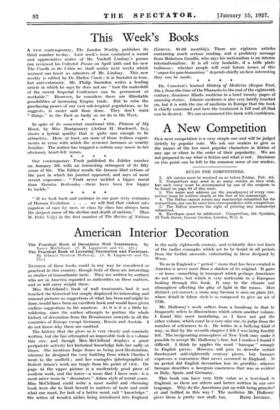American Interior Decoration
The Practical Book of Decorative Wall Treatments. By Nancy McClelland. (J. B. Lippincott and Co. 42s.)
NErrimn of these books could in any way be considered as practical in this country, though both of them are interesting as studies of transatlantic taste. They are written by authors who are in America regarded as authorities on these matters, and so will carry weight there.
Miss McClelland's book of wall treatments, had it not touched the historical but simply displayed its interesting and unusual pictures as suggestions of what has been and might be done, would have been an excellent book and would have given endless suggestions to the amateur. As it is it is a little be- wildering, since the author attempts to portray the whole history of decoration from the Renaissance onwards in all the countries of Europe except Germany, Russia and Austria. I do not know why these are omitted.
The history that she gives us is very clearly- and concisely written, but she has attempted an impossible task in a volume this size, and though Miss McClelland displays a great peripatetic activity her historical knowledge fails her sadly at times. She mentions Inigo Jones as being post-Restoration, whereas he designed the very building from which Charles •I went to the scaffold ; and her examples (photographic) of Robert Adam's work are tragic from his point of view. On page 45 the upper picture is a moderately good piece of modern work, and the lower—a room . that I have seen—is a most naive room in " decorators " Adam style of recent years. Miss McClelland could write a most useful and charming book were she to limit herself to matters of taste and omit • what one must, for lack of a better word, call " knowledge.".. She writes of wooden niches being introduced into England
in the early eighteenth century, and evidently does not know of the earlier examples which are to be found in all periods from the Gothic onwards, culminating in those designed by Wren.
To us in England a " period " room that has been created in America is never more than a shadow of its original. It gains —or loses—something in transport which perhaps Americans do not notice, but which is very noticeable to a European looking through this book. It may be the climate and atmosphere affecting the play of light in the rooms. How distinct, yet correct, a room may become is seen on plate 511, where detail in Adam style is so composed to give an air of
1730. •
Mr. Holloway's work suffers from a handicap in that he frequently refers to illustrations which adorn another volume. I found this most tantalizing, as I have not got the other volume, which must be a very nice one, to judge from the number of references to it. He writes in a bullying kind of way, so that by the seventh chapter I felt I was being forcibly fed. The invigorating atmosphere of New York may make it possible to accept Mr. Holloway's fare, but I confess I found it difficult. I think he applies the word " baroque " wrongly to English pieces. Roccoco will pass to describe certain flamboyant mid-eighteenth century pieces, but baroque expresses a coarseness that never occurred in England. At no period did English decoration lose its gentility, whereas baroque describes a bourgeois coarseness that was so evident in Italy, Spain, and Germany.
This book can have very little value as a text-book in England, as there are others and • better written in our own language. Why do the Americans put up with being preached at and bullied in this way ? The medicine Mr. Holloway
gives them is pretty raw stuff, too. BASIL IONIDES.


































 Previous page
Previous page